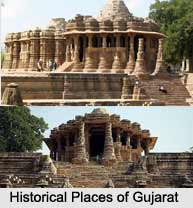 Historical places of Gujarat narrate the ancient past and their diverse influences on the region. Being the land of Mahatma Gandhi, the place has played a crucial role in the freedom struggle of India. Ancient history and the journey of the place towards modernization can be well understood in these places. Gujarat has been inhabited since the prehistoric era and has undergone through different phases including the ancient, medieval and modern. Monuments, brilliant architecture, rituals and many other aspects can be well explored by visiting these places. These also enrich the national heritage of the country.
Historical places of Gujarat narrate the ancient past and their diverse influences on the region. Being the land of Mahatma Gandhi, the place has played a crucial role in the freedom struggle of India. Ancient history and the journey of the place towards modernization can be well understood in these places. Gujarat has been inhabited since the prehistoric era and has undergone through different phases including the ancient, medieval and modern. Monuments, brilliant architecture, rituals and many other aspects can be well explored by visiting these places. These also enrich the national heritage of the country.
Hriday Kunj
Hriday Kunj is a significant historical site, famed for being the place where Mahatma Gandhi dwelled. It a small house which served as a place where non violence movement and freedom struggle was initiated by Gandhiji. This house at Gandhi Ashram has been preserved as a national monument. The place in ancient times has also sheltered the untouchables. Different handicrafts, spinning wheels and handmade papers can also be found here. A central library is located adjacent to Hriday Kunj and `Sight-and-sound` show is conducted for tourist and visitors. Another place of historical significance is situated nearby which is a large prayer ground. Gandhi Ashram also houses a museum which preserves and showcases documents and articles of the Indian national movement.
Kirti Mandir
Kirti Mandir is another national monument of Gujarat. The place is also famous for being the birthplace of mythological character Sudama who was the best friend of Lord Krishna. Thus the place also holds religious significance.
Vadnagar
Vadnagar is another historical town which is known for Hatkeshwar temple and torans. Torans are a pair of columns, belonging to 12th century, which supports an arch. These are about 40 feet in height and are made of yellow and red sandstone. These majestic torans stand along the bank of Sharmistha Talav. During the rule of Solanki dynasty, Gujarat was adorned with entrance gates and these torans are the relics of those ancient architecture. Their carving style has resemblance with the Rudra Mahalaya at Sidhpur. The torans are embellished with carvings of hunting and battle scenes which raises the concept that these might have been built after a war victory. Presently it serves as the symbol of Gujarat. Some theories state that these torans were the entrance of some temple complex but no evidences of such existence has been found yet.
Hatkeshwar temple belongs to 17th Century and stands at the entrance of the town. Nagar Brahmins, once an important community of Vadnagar, consider deity of the temple as their family deity. Inner sanctum of the temple hosts a Shiva linga which is said to have emerged on its own. A high wall covered by three circular domes surrounds the temple. Images of regent deities, evocative dancing apsaras, musicians, nine planets, the principal gods of Hindu pantheon, animal and floral motifs and scenes from Mahabharata and Ramayana adorn the outer part of the temple in most elegant manner. An old Kashivishveshvara Shiva temple, two Jain temples and a Swaminarayan temple are also situated in the premises.
Champaner-Pavagadh
Champaner-Pavagadh is enlisted among the most important historical sites of the country and is also declared as a UNESCO world heritage site. It is also promoted as an attractive tourist destination. The place unfolds 1,200 years of history and culture and has witnessed the era of Indian Purans, the saga of Rajputs, the reign of Marathas, various influences of Islam and finally the colonial rule over the country. The Muslim influence started in the region with the advent of Muhammad Begada who established his rule by defeating Patai Raval clan who were the former rulers of the region. He also shifted his capital to Champaner from Ahmedabad. Panchmahal is located nearby and is famous for being a tribal area inhabited mainly by Bhils.



















